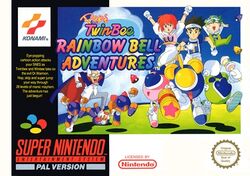Software:Pop'n TwinBee: Rainbow Bell Adventures
| Pop'n TwinBee: Rainbow Bell Adventures | |
|---|---|
 PAL version cover art | |
| Developer(s) | Konami |
| Publisher(s) | Konami |
| Director(s) | Yoshiharu Kambe |
| Composer(s) |
|
| Series | TwinBee |
| Platform(s) | Super Nintendo Entertainment System |
| Release | |
| Genre(s) | Platform |
| Mode(s) | Single-player, multiplayer |
Pop'n TwinBee: Rainbow Bell Adventures[lower-alpha 1] is a side-scrolling platform game published and developed by Konami for the Super Nintendo Entertainment System. The game was originally released in Japan on 7 January 1994. Rainbow Bell Adventures is the first platformer in the TwinBee series, departuring from the vertically scrolling shooter genre.
Gameplay
Pop'n TwinBee: Rainbow Bell Adventures features three playable characters: Twinbee, Winbee or Gwinbee.[2] All characters use their punch to attack, which can be charged to unleash a punch wave. They have two sets of weapons, one of them is either a short or long-ranged weapon (a hammer for Twinbee, a lasso for Winbee, and throwing rattles for Gwinbee), and the other one is a gun, which is a reference to Detana!! TwinBee's cutscene, in which Twinbee is shown with two guns on each hand. All three can temporally fly in eight directions by propelling via a rocket pack that must be charged, as well as hover.
Aside from their weapons, the major difference between the characters is the time they require to fully charge their punch wave or their rocket propeller: Twinbee has an average charging time; Winbee charges her rocket propeller the fastest, but takes the most to charge a punch wave; Gwinbee, on the other hand, fills charges his punch quickly, but takes a while to charge his propeller.
The bell power-up from the rest of the series also appears here, and it allows any of the characters to obtain various kinds of power-ups, depending on the color of the bell, such as the sets of weapons, the gun, speed, options and invincibility. Unlike other Twinbee games, the bells are obtained by defeating enemies instead of shooting clouds.
The game also features a versus mode, in which players must defeat their opponents for three rounds.
Regional differences
- The level order in the Japanese version is a set of levels arranged in a quadrilateral form, with an interconnection between different stages. Some stages have alternate exits, similar to Super Mario World. In the European version, the order is strictly linear and a specific level can't be accessed if the previous ones aren't cleared.
- The dialogue by Dr. Cinnamon and the pilots (Light, Pastel and Mint) at the level select screen were deleted in the European version.
- The European release only uses passwords for saving data; and the Japanese version uses primarily an internal battery back-up, but the passwords are also an option.
- The Japanese version has multiple endings depending on the player's performance.
Reception
Upon release, Weekly Famitsu gave it a score of 28 out of 40.[3]
M! Games magazine gave it a score of 77 out of 100.[5]
Mega Fun gave it a score of 82% overall.[6]
Super Play gave the game a score of 70%.[8]
Total! 2+ (B+)[7]
SuperPro 72%[10]
Fun Vision[11]
Video Games 72%[9]
Notes
- ↑ Released in Japan as TwinBee: Rainbow Bell Adventure (ツインビー~レインボーベルアドベンチャー~).
References
- ↑ "id Software". Edge (Future) (5): 34. February 1994. ISSN 1350-1593. https://archive.org/stream/EDGE.N005.1994.02/EDGE.N005.1994.02-Escapade.4900px#page/n33.
- ↑ "【1月7日】今日は『ツインビー レインボーベルアドベンチャー』の発売24周年!【レトロゲームの誕生日】". Gamedrive. January 7, 2018. https://gamedrive.jp/news/1515286801.
- ↑ Jump up to: 3.0 3.1 "ツインビー 〜レインボーベルアドベンチャー〜 [スーパーファミコン / ファミ通.com"]. https://www.famitsu.com/cominy/?m=pc&a=page_h_title&title_id=1350.
- ↑ "Super Famicom Review: Twinbee The Rainbow Bell Adventures". Consoles +: 124–126. March 1994.
- ↑ Jump up to: 5.0 5.1 "Pop'n TwinBee: Rainbow Bell Adventures - im Klassik-Test (SNES) – MANIAC.de" (in de-DE). MANIAC.de. 2016-11-18. https://www.maniac.de/tests/popn-twinbee-rainbow-bell-adventures-im-klassik-test-snes/.
- ↑ Jump up to: 6.0 6.1 Appel, Markus; Schneider, Ulf (April 1994). "Pop'n Twinbee The Rainbow Bell Adventures". Mega Fun.
- ↑ Jump up to: 7.0 7.1 "SNES: Pop'n TwinBee Rainbow Bell Adventure" (in DE). Total!: 38–39. March 1994.
- ↑ Jump up to: 8.0 8.1 "UK Review: Pop'n TwinBee: Rainbow Bell Adventure". Super Play (Future Publishing) (18): 36–37. April 1994.
- ↑ Jump up to: 9.0 9.1 "Rom Check: Pop'n Twinbee zu FuB Rainbow Bell Adventure" (in DE). Video Games: 91. March 1994.
- ↑ Jump up to: 10.0 10.1 "Super NES review: Rainbow Bell Adventures" (in DE). SuperPro: 21. March 1994.
- ↑ "Pop'n Twinbee The Rainbow Bell Adventure" (in DE). Fun Vision: 34–39. July 1994.
External links
 |

